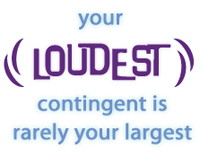Your Forgotten Audience
Recently an author client reported to me that she thought her blog posts that related to her books/writing and her site should be phased out. She had received some emails from her fan base saying they preferred her posts that were focused on life: motherhood, weight issues, relationships and such. In response, she wanted to be in line with what her audience wanted.
 Okay, so this may be true for those dozen (or three) people who wrote in. And I absolutely respect how loudly such comments can color your opinion of your own content. But do not forget, that your loudest contingent is rarely your largest, most representative, or your only. This is directly related to: what your audience wants may not necessarily be what your business goals dictate, but that’s fodder for a different topic.
Okay, so this may be true for those dozen (or three) people who wrote in. And I absolutely respect how loudly such comments can color your opinion of your own content. But do not forget, that your loudest contingent is rarely your largest, most representative, or your only. This is directly related to: what your audience wants may not necessarily be what your business goals dictate, but that’s fodder for a different topic.
When designing your content you must consider all your audience sectors — the hard-core invested, the curiously interested, and the merely intrigued. You need both sales content and reinforcement content. You need several lures. You can’t put it all on your home page, (that will look like a circus), but nor can you fill your blog with only one audience appeal. These are your portals. This is where your audience –all of it– first sees you. Be welcoming and encouraging. Optimized content (and UI for that matter) should consider that your audience consists of varying levels, with varying needs.
Granted, there are definitely instances where a single comment can bring a valid issue to light. A client once had us change something on her site that required over three hours of work to accomplish. This in response to one email from a single librarian who thought something was confusing. In this case, it was confusing, and directly related to understanding a specific product. We –on the inside– had never seen it as such.
Here is a short tale of what it feels like to be the audience who is forgotten (or jump to the upshot at the bottom of this post):
For me, it was yoga. Once upon a time I went somewhat regularly. Then life, motherhood, and work messed with my schedule and suddenly I was years out and my stamina was gone. Every time I tried to get back to yoga I felt like the cross-eyed stepchild in the back of the room who couldn’t hold a downward facing dog for any respectable stretch.
I passed my neighborhood yoga studio and looked at the window wistfully and longingly. I felt that they did not have classes for me. I couldn’t justify the time for something I knew I wouldn’t get, and when I did I was disheartened by the end. I needed to be eased back in. I needed shorter, more basic classes and my neighborhood studio felt closed to me. I was a different audience from the norm. I knew I wasn’t alone because I’d heard the moms at the local park talking, and when I caught snippets of the conversation of the people in front of me in line at Trader Joe’s describe going to said studio as intimidating, I thought: Well, that’s just bad branding.
I finally said something to the studio, and they were stunned. Of course we have classes for you!
Maybe I had just missed it. So I looked again at their newsletter, pointing to info about advanced workshops. New level 2 classes, etc. Well, that’s what our regulars were asking for. And the woman behind the desk brought up their site on her computer, clicked around, and then proudly showed me a class embedded in the schedule with the subtitle: Ideal for beginners, seniors, and rehab.
Okay. Sure. You need to appeal to your regulars. I get that. But how can you grow your audience if you ONLY appeal to those you already have? How was I supposed to know where to look? Or, as a woman in her 40s, did I really want to classify myself as a senior?
I suggested a small invitation in their window, website, and on their newsletter: NEW TO YOGA? or EASE YOGA BACK INTO YOUR LIFE or WE HAVE BEGINNER CLASSES! They needed something inviting that spoke to this forgotten audience — Yes, we have content for you. Follow this little icon to these classes…
Upshot / Moral of the story: Diehards will ignore what they don’t love. They will remain devoted unless you tick them off. The quiet, forgotten audience will rarely speak up…and you need them, too.


